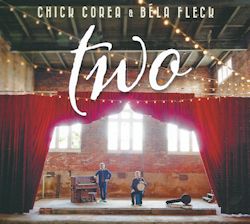CD1
1. Chick Corea’s Intro
2. Señorita
3. Menagerie
4. Béla Feck on the Waltse
5. Waltse for Abby
6. Chick Corea and Béla Fleck on Joban
7. Joban Dna Nopia
8. The Climb
9. Mountain
CD2
1. Brazil
2.The Enchantment
3. Béla Fleck on Bugle Call
4. Bugle Call Rag
5. Chick Corea and Béla Fleck on Dutilleux
6. Prelude en Berceuse
7. Children’s Song No.6
8. Chick Corea and Béla Fleck on Spectacle
9. Spectacle
10. Sunset Road
11. Armando’s Rhumba
Chick Corea – Piano
Béla Fleck - Banjo
Béla Fleck has almost single-handedly rescued the banjo from those eternal banjo jokes which poke fun at the poor instrument, mainly because it is
considered cacophonous or tuneless (e.g. “What do you call a musician at a banjo contest?” “A visitor”.) Despite the jokes, banjo players have been some of
the most dextrous players on earth, especially among exponents of bluegrass. Béla Fleck brought out into the open this dexterity through his group the
Flecktones, which managed to blend bluegrass with jazz. The mix of these genres is continued in these duets with Chick Corea. In the sleeve-notes, Béla
says that when Chick Corea invited him to play some duets, he had to reply: “I’m not a real jazz musician, and I don’t have the understanding of harmony
that most of the people you play with has”. Chick’s response was “Let me worry about that part. You just do what you do, and I’ll make it work”.
Chick made it work. That is proved by this double CD of recordings made during their concert tour. Part of the success is due to Béla Fleck’s innate
talent, which is not that far from jazz. Many of the tracks consist mainly of improvisation by both men: often swirling around one another in strange
counterpoint, then suddenly coming together again with incredible precision. The improvisations are so free as sometimes to result in discord or imbalance.
For instance in the opening track, Béla seems to get out of sync with Chick. And some of the extemporizations are so long that they seem as self-indulgent
as they are inventive. I would have welcomed more melody and less noodling, however precise that improvisation may be.
I had hoped that things would be clearer in familiar tunes like Brazil or Armando’s Rhumba, but the players perform them so freely that
it is often difficult to know where you are – or even recognise the tune. Besides the lack of clear melodies, there is a lack of swing most of the time, as
the banjo’s staccato style inhibits swinging. Nevertheless one can enjoy the sheer virtuosity of the playing and the rapport between the duettists. And Bugle Call Rag swings in the style of bluegrass.
I wonder how accessible this music will be to the average audience. Listeners may be overawed and perhaps a little bewildered.
Tony Augarde
www.augardebooks.co.uk
